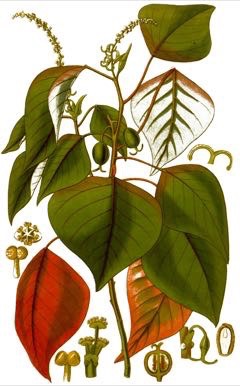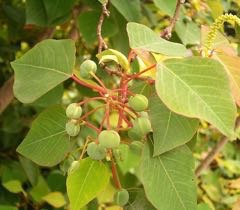 |
|
http://www.edibleplants.org |
 |
| Frank Vincentz wikimedia |
Translate this page:
Summary
Bleeding Heart or Homalanthus populifolius is an evergreen, erect shrub to small tree with an open and spreading crown. It grows up to 12 m tall with a trunk diameter of up to 15 cm. It is commonly found in rainforests in Australia. Its is fast-growing but fairly short-lived. The leaves are triangular and alternate, and turns red when senescent. Flowers are yellow green to red. The fruits are eaten by birds. Bleeding heart is an important pioneer species used in landscape rehabilitation projects. The bark and leaves yield black dye which is used for staining baskets and other similar items.
Physical Characteristics

 Homalanthus populifolius is an evergreen Shrub growing to 5 m (16ft) by 6 m (19ft) at a fast rate.
Homalanthus populifolius is an evergreen Shrub growing to 5 m (16ft) by 6 m (19ft) at a fast rate.
See above for USDA hardiness. It is hardy to UK zone 10.
Suitable for: light (sandy) and medium (loamy) soils, prefers well-drained soil and can grow in nutritionally poor soil. Suitable pH: mildly acid, neutral and basic (mildly alkaline) soils. It can grow in full shade (deep woodland) semi-shade (light woodland) or no shade. It prefers moist soil.
UK Hardiness Map
US Hardiness Map
Synonyms
Carumbium pallidum Mull.Arg. Carumbium platyneuron Mull.Arg. Carumbium populifolium (Graham) Benth.
Plant Habitats
Edible Uses
References More on Edible Uses
Medicinal Uses
Plants For A Future can not take any responsibility for any adverse effects from the use of plants. Always seek advice from a professional before using a plant medicinally.
None known
References More on Medicinal Uses
The Bookshop: Edible Plant Books
Our Latest books on Perennial Plants For Food Forests and Permaculture Gardens in paperback or digital formats.

Edible Tropical Plants
Food Forest Plants for Hotter Conditions: 250+ Plants For Tropical Food Forests & Permaculture Gardens.
More

Edible Temperate Plants
Plants for Your Food Forest: 500 Plants for Temperate Food Forests & Permaculture Gardens.
More

More Books
PFAF have eight books available in paperback and digital formats. Browse the shop for more information.
Shop Now
Other Uses
Dye Pioneer
Agroforestry Uses: A natural and important pioneer species within its native range, the tree quickly invades cleared land and fresh clearings in the forest. A short-lived tree, it quickly provides the shelter needed to allow the more permanent forest trees to become established, and then dies off to allow those species the necessary space to grow to full size[694 , K ]. It is used as a pioneer tree in landscape rehabilitation projects[327 ]. Other Uses: A black dye is obtained from the bark and leaves[46 ]. It is used for staining baskets and other items made from rattan and Corypha palms[46 ].
Special Uses
Food Forest
References More on Other Uses
Cultivation details
Found in the wild growing on coral rubble, sandy soil and brown loam[327 ]. Trees are fast-growing, but fairly short-lived[694 ]. They can be 3 metres tall at the end of their first year from seed[694 ]. Flowering Time: Mid Spring Late Spring/Early Summer Mid Summer. Bloom Color: Cream/Tan. Spacing: 8-10 ft. (2.4-3 m).
References Carbon Farming Information and Carbon Sequestration Information
Temperature Converter
Type a value in the Celsius field to convert the value to Fahrenheit:
Fahrenheit:
The PFAF Bookshop
Plants For A Future have a number of books available in paperback and digital form. Book titles include Edible Plants, Edible Perennials, Edible Trees,Edible Shrubs, Woodland Gardening, and Temperate Food Forest Plants. Our new book is Food Forest Plants For Hotter Conditions (Tropical and Sub-Tropical).
Shop Now
Plant Propagation
Seed - it has a short viability and so needs to be sown as soon as it is ripe[694 ]. Cuttings root easily[694 ].
Other Names
If available other names are mentioned here
Bleeding Heart, Queensland Poplar
Native Range
TROPICAL ASIA: Papua New Guinea, Solomon Islands AUSTRALASIA: Australia (New South Wales (east), Queensland (east))
Weed Potential
Right plant wrong place. We are currently updating this section.
Please note that a plant may be invasive in one area but may not in your area so it's worth checking.
Conservation Status
IUCN Red List of Threatened Plants Status : This taxon has not yet been assessed

Growth: S = slow M = medium F = fast. Soil: L = light (sandy) M = medium H = heavy (clay). pH: A = acid N = neutral B = basic (alkaline). Shade: F = full shade S = semi-shade N = no shade. Moisture: D = dry M = Moist We = wet Wa = water.
Now available:
Food Forest Plants for Mediterranean Conditions
350+ Perennial Plants For Mediterranean and Drier Food Forests and Permaculture Gardens.
[Paperback and eBook]
This is the third in Plants For A Future's series of plant guides for food forests tailored to
specific climate zones. Following volumes on temperate and tropical ecosystems, this book focuses
on species suited to Mediterranean conditions—regions with hot, dry summers and cool, wet winters,
often facing the added challenge of climate change.
Read More
Expert comment
Author
Graham
Botanical References
1
Links / References
For a list of references used on this page please go here
A special thanks to Ken Fern for some of the information used on this page.
Readers comment
| Add a comment |
|
If you have important information about this plant that may help other users please add a comment or link below. Only comments or links that are felt to be directly relevant to a plant will be included. If you think a comment/link or information contained on this page is inaccurate or misleading we would welcome your feedback at [email protected]. If you have questions about a plant please use the Forum on this website as we do not have the resources to answer questions ourselves.
* Please note: the comments by website users are not necessarily those held by PFAF and may give misleading or inaccurate information.
To leave a comment please Register or login here All comments need to be approved so will not appear immediately.
|
Subject : Homalanthus populifolius
|
|
|
|